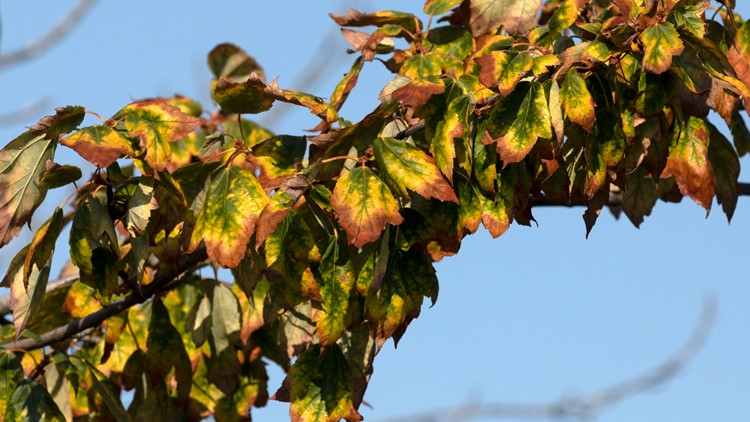MAINE, USA — This summer's drought is expected to cause a patchy array of fall color starting earlier in the leaf-peeping haven of New England while the autumn colors are likely to be muted and not last as long in the drought- and heat-stricken areas of the south.
In New England, experts anticipate the season, which typically peaks in October, to be more spread out with some trees changing earlier or even browning and dropping leaves because of the drought. Other places, like Texas, could see colors emerging later in the fall due to warm temperatures.
“We will still have brilliant colors in New England because of the fact that we have so many different kinds of trees and they’re growing on kind of ridges and kind of slopes and wetlands,” said Richard Primack, a professor of plant ecology at Boston University. “You know we will have good color but the color will probably be more spotty than usual.”
Leaf peeping is big business in places like New England, where millions of visitors from around the country and world bring in billions of dollars.
Everyone from inns to diners often count on this business to get them through the rest of the year. But predicting when those colors will peak is not an exact science; requiring experts to consider everything from temperature, the length of the day and stresses like pests and drought.
In Vermont, the 18-room Mad River Barn, an inn in Fayston, typically sells out for about three weeks in a row starting in late September, said inn manager Jess Kotch. But those leaf-peepers don’t make reservations far in advance.
“Typically we get so many inquiries for last-minute stays through that period that I don’t even really start thinking about it until this week and next week,” she said.
This year, drought is one of the big concerns in many parts of the country.
Severe and even extreme drought set in this summer in southern New England and remains in some areas, while up north parts of Vermont, New Hampshire and Maine are in a moderate drought or are abnormally dry. In those northern New England states, the color will depend on the health of the individual trees and is expected to be good to variable.
“Where you have those real dry sandy soils or you know, trees that have had health issues accumulating over time you may see some effect on fall foliage on those trees,” Wendy Scribner, a forestry field specialist with the University of New Hampshire extension service, said. “But I think we just have so many of them that we still will see some coloration.”
In Oklahoma, where much of the state is in severe or extreme drought, the trees are expected to change earlier than usual and it will be quicker. Some oak trees started browning and dropping leaves this summer, said Alex Schwartz, district silviculturist for the Oklahoma Ranger Districts of the Ouachita National Forest.
“When the trees experience moderate to severe drought stress like we’ve had, what they’re going to do is they’re going to probably stop that production — what little they’ve had over the summer —- stop that production a lot quicker, and they’re not going to produce a lot of those other pigments like the carotenoids that bring out those other fall colors,” he said.
The same thing is happening on some ridgetops in Connecticut where oak trees in thin dry soils are browning and dropping leaves early, meaning they're shutting down. And many southern New England beech trees, whose leaves typically turn yellow and orange in the fall, have been hit by beech leaf disease, causing them to drop their leaves, said Robert Marra, a forest pathologist at the Connecticut Agricultural Experiment Station.
“It's going to have a very serious impact on fall colors in the sense that most of the beeches, many of them throughout southern New England, were hit so badly by beech leaf disease this year that they’re just dropping, they don’t have leaves on them to change color,” he said.
In Texas, the colors are likely to be muted and warm temperatures could push back the change, said Mac Martin, partnership coordinator for Texas A&M Forest Service.
“We’re going to probably get a shorter window of the fall colors that we get here in general as well as probably less kind of brilliant colors,” he said.
Visitors to the White Mountain Hotel and Resort in North Conway, New Hampshire, are not holding off in making reservations, said Carol Sullivan, director of sales and marketing.
“The last two years for us have been very strong, and that is the same prediction for us this year, that we will have an equally strong, if not even stronger, fall foliage season, regardless of what the weather does,” she said.
More NEWS CENTER Maine stories



